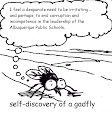Where else has growth in technology produced so little bang for the buck? If improved technology could somehow be held accountable for its use in public education, it would be a failed endeavor.
The effort to connect children and the world of knowledge; the "internet" for want of a better word, and helping them learn how to use it to learn how to learn about everything, is failing.
Unless you're inclined to blame teachers, parents or students for (education) technology's pitiful bang for the buck; you have to blame the powers that be.
What else could it be?
In the Albuquerque Public Schools there is nearly a hundred thousand years of teaching experience because, in average public school districts, teachers average seven years of ongoing experience each.
They have among them as well, whatever continuing education and training they have undertaken while they were teaching. They are the single best resource for an answer if ever the question is asked;
why isn't this working?The question isn't asked by the powers that be, because the answer is; the powers that be are responsible for demanding that teachers ignore their education, experience and instincts, and follow instead a path to almost certain failure.
Even you could form children into thought choirs,
why would you want to?
How in this day and age, can we still be insisting that children with nothing in common but their age and the neighborhood they live in, be expected to think and learn in unison; at the same time and all at the same speed? Six rows of five desks, each child on the same page in the same book at the same moment; no matter where else their natural curiosity and motivation might otherwise compel them to be.
If you believe in mass standardized testing of children; a huge money maker, you must must also believe in mass teaching and learning. The one requires the other. Students can't learn at their own speed if every time they pass the start/finish line, they all have to be there together; dutifully arranged in five rows of six.
 How is it that with all the technology available to us, we cannot teach nearly any child to learn how to learn; any where, any time and for for a few tens or hundreds of dollars per child?
How is it that with all the technology available to us, we cannot teach nearly any child to learn how to learn; any where, any time and for for a few tens or hundreds of dollars per child?And yes, there do need to be community schools where students working in groups with the same immediate goal, makes sense. There need to be neighborhood school buildings and schools for a number of equally important uses.
The stodgy thinking that holds back public education is not the thinking of teachers, it is the thinking of people who for the most part haven't been in a classroom for years.
There's a reason school board member and senior administrators
don't regularly substitute teach the curriculum they demand,
in the manner in which they demand that it be taught, and
under the circumstances they expect teachers to deliver it.
photo Mark Bralley

No comments:
Post a Comment